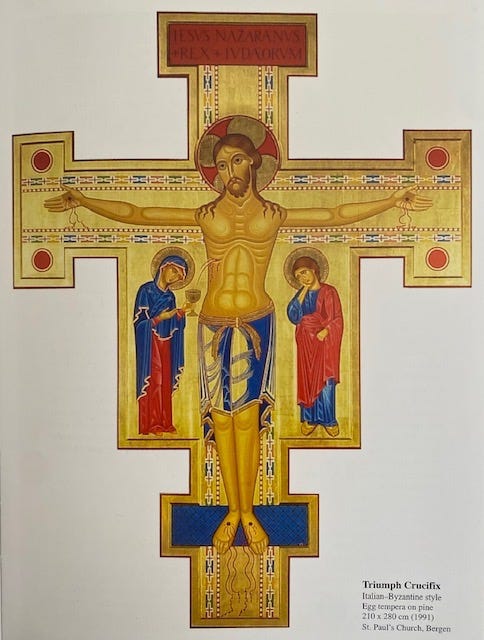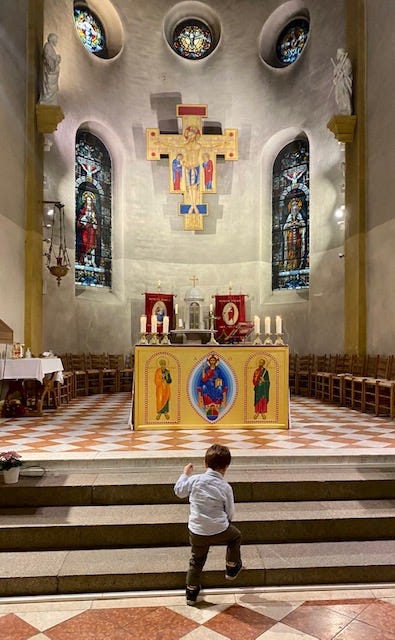From 1991: The Cross in St. Paul's Catholic Church, Bergen (free post)
A theological explanation by art historian, professor, and deacon Henrik von Achen
More than thirty years ago, I was commissioned to create the artwork for the chancel and altar furnishings at St. Paul’s in Bergen, Norway. I was also commissioned to make the large cross above the altar. Henrik Louis von Achen (director of the University Museum in Bergen, professor of art history and theology, and deacon in the Catholic Church) describes the crucifix and its details in this essay, written in 1991, and originally included in my book, The Mystical Language of Icons.
St. Paul’s Church in Bergen has a large, new crucifix. It is the most important decoration in the church, visible to everyone from its dominating place in the choir. Therefore a few words about our special crucifix would not be out of place. Different styles of crucifix place slightly different emphases on the message they wish to convey. In other words, the actual form a crucifix is given has something to impart. First and foremost, each crucifix proclaims a particular teaching about who Christ is – a Christology – and therefore also something about whom we receive in Communion – a Eucharistic theology.
Our new crucifix is of a style found in Italian art in the 13th century and bears obvious signs of the Byzantine current which influenced Italian art at that time. It is the work of the icon painter Solrunn Nes, who is member of St. Paul’s congregation. The committee chose this Italian type for several reasons. Our starting point should be the West European roots of our church. We did not want an icon crucifix, but rather a work belonging to our West European tradition. On the other hand, the Byzantine influence made it possible to a greater degree for the artist to work in accordance with a certain style, without producing a copy in the usual meaning of the word. The crucifix has an Italian prototype, but is nevertheless a unique work without a parallel anywhere in art history. The Italianesque, and the place of this type in time, have a close relationship with the church building itself, which is Italianesque with certain Romanesque features.
Another reason for choosing the Italian-Byzantine tradition, as a starting point, has to do with its color intensity. We wanted a strong coloristic focal point in the choir as a contrast to the light grey and white tones otherwise found in the church. Nevertheless, a simple color scheme is used: gold, blue, and red.
However, most important is that with this crucifix we have a Christ characterized by simplicity and dignity. He is looking at us. The figure is not hanging on the cross in dramatic suffering, but appears almost to “float” in front of the cross with outstrethed arms. In Christ’s face we find a tranquility, a gentleness – and a humanity that reaches out to us. But there is also a certain gaze. Jesus has turned and seen someone. Peter, the Rock of the Church, he who denied his Master. When Peter met that look “he went out and wept bitterly” (Lk 22, 61). Not least here at the end of Lent, it is meaningful to remember that we, the Church of Christ, live under the gaze of Christ. We too are wanting, we too can deny. What is the Fast other than a time of weeping for oneself? We begin every mass by confessing our sins. Christ’s gaze from the cross reminds us of that.
Furthermore, this motif concerns the living God. The crucifix shows us what takes place in the Mass; that the resurrected Lord, for a moment, so to speak, descends and communicates with his people through the bread and wine. The sacrifice of the Mass is an anamnesis, i.e. the Church, through the sacrament, remembers Jesus’ sacrifice on the cross in such a manner that the sacrifice once again becomes a present reality for us, without it being reenacted. Jesus died on the cross only once. Therefore Christ is not portrayed with the harsh realism of Golgotha, but we see on the cross the Lord who “lifted up from the earth, will draw all men to himself” (Jn 12, 32). It is He who is, and will be present in the Eucharistic elements, and it is He whom we receive in Communion. The crucifix does not descibe a definite historical event, but recounts what happens in the Mass. In the Mass we give thanks for God’s will to redeem us and are filled with gratitude for his boundless love, which through the sacrifice on the cross was given its unique manifestation. Therefore we speak of the Mass as “eucharistic” – as a thanksgiving.
Even so, the crucifix also holds memories of the hours of suffering at Golgotha. We see a Calvary group, a motif with long traditions in ecclesiastical art history. The group consists of the crucified Christ flanked by his mother, Mary, and John, the disciple he loved. These two represent respectively the Church and all mankind. We remember the Gospel according to John, where from the cross Jesus says to Mary, with an eye to John: “Woman, look to your son,” and to John: “Look to your mother.” Thus Jesus established a relationship between the Church and mankind, a relationship marked by the love he himself is distinguished by.
Mary is holding out the chalice to receive the blood of Jesus. This motif was chosen expressly to associate the crucifix with what happens at the altar during every Mass, namely, that the bread and wine become the Lord’s body and blood, in remembrance of the sacrifice of the cross. As a congregation, we share in the fruit of that sacrifice, and become one in Christ; through this participation, through fellowship – that is to say, through the Communion. Mary with the chalice symbolises the Church, which through the Mass mediates to new generations throughout the ages the radiant reality of the sacrifice of the cross. The crucifix thus gains a new meaning if we look more carefully at where it is placed. It hangs in the choir between two stained glass windows. And what do they portray? On the right Christ who holds the chalice, the king and high priest of the New Covenant, and on the left Melchizedek, the king and high priest of the Old Covenant, who carried forth bread and wine and thus anticipated the sacrificial elements of the New Covenant. To portray a New Testament event and its Old Testament counterpart, is a very old catechistic technique for illustrating how the Old Testament anticipates and gives notice of what will come to pass in the New Testament. Between the stained glass windows’ presentations of the Eucharist in an OT and NT perspective, the crucifix presents us to the Church; Christ’s mystical body: “You are a chosen race, a royal priesthood, a holy nation, God’s own people” (1 Pet 2,9). Thus the crucifix with its motifs introduces a perspective of time which also includes us in the twentieth century: “and lo, I am with you always, even unto the end of the world” (Mt 28, 20).
Henrik von Achen
April 1991






